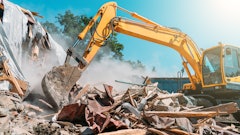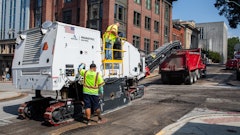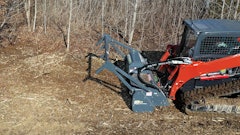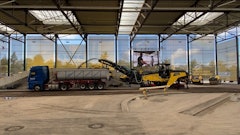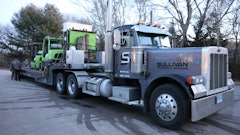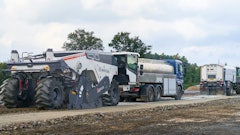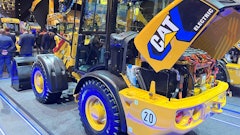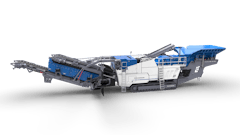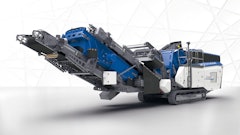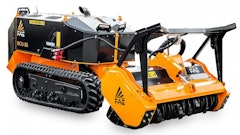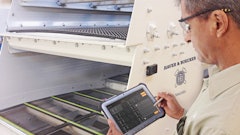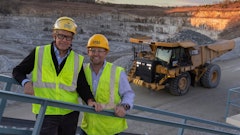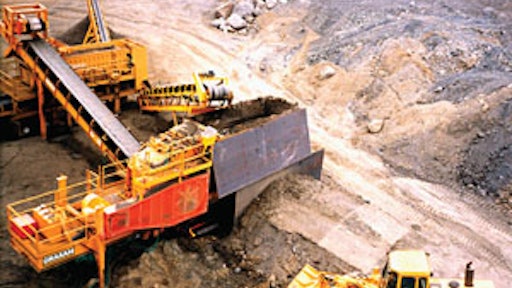
In an industry where downtime usually makes the difference between profit and loss, proper and diligent maintenance practices should be a major part of every crushing operation. But don’t become paranoid about it and overdo in the extreme. That can actually cause you problems.
Four experienced crushing professionals offer their views on proper maintenance of horizontal impactor plants used for crushing limestone, concrete and asphalt rubble. An impact crusher requires more maintenance than a jaw crusher, but each operator believes the impactor to be more efficient for concrete and asphalt recycling, and for crushing most limestone.
Each expert emphasized the obvious importance of following the manufacturer’s maintenance schedule and procedures.
John Thompson, president, Thompson Recycle, Tecumseh, MI
Thompson Recycle crushes about 95 percent asphalt rubble. The company employs an electric-motor-powered Grasan road-portable crushing plant with a Hazemag 1515 APSE horizontal-shaft impactor. Thompson states:
We run our crushing operation from March 15 through December 15. We’ve been in business for about nine and a half years and have moved from one site to another more than 500 times. We’ve crushed about 14 million tons of asphalt rubble, and our plant is still solid, efficient, dependable and runs like a top.
You need two things to get that kind of performance. First, get a top quality crushing plant designed for your specific needs. Second, establish a sensible maintenance and repair schedule and stick to it no matter what. A good quality crusher will last 10 to 15 years, according to most manufacturers. I say if that’s all you’re getting, you aren’t servicing it properly. I look to get 20 to 25 years from my impactor plant.
Some crushing operators don’t want to spend the money to replace wear parts as needed, or don’t want to shut down long enough to pull proper maintenance. But without proper maintenance, you can ruin a good crusher in six weeks to six months. That’s the difference. It’s your choice, and it should be an easy one. But it’s not for some people. Wear parts are expensive. But breakdowns are much more expensive.
If you don’t replace your blow bars on time, for example, you can end up spending big bucks on a new rotor before long. Material being crushed can eat away the rotor surface if the blow bars are worn too low.
Almost all our maintenance is preventive, and it’s done daily or weekly as needed. We can’t afford breakdowns, and we have practically none. We run 24 hours a day in two 12-hour shifts, six days a week — with a seven-person crew, including me. At the start of each shift, we check over the entire plant, make any adjustments and make note of the condition of major wear parts. During our three-month winter layoff, we make any needed major repairs.
Since we move our plant a lot during the work year, we try to replace wear parts when we shut down for the move. We’re productive about 73 percent of the time. The rest is for maintenance and moving.
We use two blow bars and two dummy bars for balance and to protect the rotor. We turn the blow bars about every 20,000 to 25,000 tons. So we get about 80,000 to 100,000 tons before blow bar replacement. We get about 700,000 tons per turn on the mono-block apron, and about 200,000 tons on the apron rear impact plates before the edge is worn off. We replace all other wear parts regularly, also, including side liners, rotor shoes, manganese apron, manganese blocks on the apron, impact plates, seals and so on.
Frank Azzopardi, plant manager, Stoneco Newport Quarry, Newport, MI
To improve operations at the giant limestone quarry near Detroit, a 4228 primary jaw crusher plant was replaced by a new Grasan pit-portable KRH1620 hydraulically controlled primary impactor plant in February 1998. The electric-motor-powered impact crusher increased production from 650 to 700 tph with the jaw to 800 tph with the impactor. Azzopardi says:
The maintenance cost is a little higher than a jaw. But the impact crusher gives us greater efficiency and a better, more cubical product with no slivers. We can reduce 24-inch limestone down to six inch minus in one step. From there it goes to secondary and tertiary cone crushers for final processing.
In less than seven years, we’ve crushed about nine million tons of shot limestone and had no unplanned downtime, just simple maintenance as we go. We operate the quarry all year, but shut down the crushing operation for three months in winter. That’s when we do our most thorough service work and make any repairs, such as belts, replacing or welding the wear liners or rotor to build it up — hard face it — things our regular work force can do. We have no mechanics on staff, so we rely heavily on durable, dependable equipment that runs and runs and runs with minimum maintenance. That kind of quality is absolutely essential.
We crush 10 hours a day, five days a week. We have three difference grades (hardness) of limestone in our quarry; so replacement of wear parts varies according to the hardness of the material we’re crushing at the time. We use four blow bars in our crusher and flip the bars about every two weeks. That equates to a high of approximately 80,000 to 100,000 tons per flip down to a low of 60,000 to 80,000 tons per flip. So a set of blow bars will last from about 240,000 to 400,000 tons before replacement.
With good maintenance practices, a good quality crushing plant will perform well for a long, long time. We’ve gotten about seven very good years from ours. I look for at least 10 more.
Butch Cherrington, vice president, Complete Resources, Columbus, OH
Complete Resources is a contract crushing company that processes concrete and asphalt rubble and aggregates with several Grasan road-portable and pit-portable impactor plants of various sizes ranging from KR1013 to KR1315. All are diesel-powered plants. Cherrington says:
We have a three-pronged approach to maintenance and downtime prevention. First, we make the plant operator responsible for regular equipment maintenance. In our case, that person is the foreman. We feel that’s better than a committee responsibility with a lot of ‘who, me?’ and finger pointing. Second, we employ several full time mechanic-welders who take care of heavy and non-scheduled repairs. Third, we try to perform maintenance as much as possible when moving equipment from one crushing site to another. That works very well for us.
A balance needs to be struck between running the plants till they break and maintaining them as good as new, because neither is profitable. If left up to production people, plants would be run into the ground in short order. If my maintenance people had the say, I would have plants in “as new” condition; but I couldn’t afford to operate them.
With diesel-powered units, make sure connections between the engine and air cleaner are tight. And run a duct from the air intake to a clean area 20 or 30 feet away — maybe more, if necessary — dust ingestion is a big problem! Without proper filtration, you can ruin an engine in days or even hours.
An oil-sample analysis program can save you a lot of engine grief. The analysis will expose air cleaner problems by identifying any high silica content or other contaminants in the oil. We have virtually no unexpected engine downtime. Some people just expect engine problems and live with them. Not us. That’s too costly and profit-killing.
You can go to electric-motor power instead of diesel to eliminate dust damage. But you have to change pulley sheaves to change speeds. Diesel power gives you instant speed variation.
Make sure you keep wear parts — especially crusher wear liners and blow bars — in stock so you won’t have delays when you need to replace them. We’re usually into the crusher once a week to check on whether blow bars or liners need replacement, and whether anything else needs to be done. When we change blow bars, we generally also change liners if they’re fairly worn, so we won’t have to shut down again soon. Leaving a little metal on the liner is less costly than another shut down.
Don’t over-grease shaft bearings on your plant. Too much grease causes the bearings to overheat. Big bearings don’t require as much grease as most people seem to think they do. Just follow the manufacturer’s schedule — no more, no less. Manufacturers know what their equipment needs, so don’t improvise. If your doctor prescribes a certain dosage of medicine, don’t take any more or any less or you could become very dead.
If you have a road-portable crushing operation, you no doubt have road-portable stacking conveyors. With folding stackers you turn the gearbox upside down for travel, and sediment — including pieces of metal — falls down into the gears. Until we figured this out, gearbox failures were a huge problem. Regular oil changes have eliminated it.
We’re a small company with two layers of management: me and the people operating the plants. We have no “official directives” regarding maintenance — just smart people who need not be afraid to shut down to fix something that isn’t totally broken. We have an unusual attitude about downtime.
Unexpected downtime is the killer. Scheduled downtime isn’t really downtime. Downtime is when equipment isn’t running outside of scheduled maintenance. Complete Resources gets everything a manufacturer expects from their equipment — and more, through proper maintenance.
Scott Weber, vice president, Weber Sand & Gravel, Lake Orion, MI
Weber Sand & Gravel is a family owned company formed in 1946. Contract crushing is a big part of the company’s business. Weber uses a custom-designed, diesel-powered Grasan KRH1515 primary impact crusher plant with an automatic hydraulic cylinder system for greater crushing capacity, smoother operation and more uniform products. Scott Weber runs the crushing division, which operates from mid-March through mid-December. Weber states:
We crush just about anything. We can crush as much as 900 tons per hour of limestone or concrete rubble down to 1” x 3”, or 500 tph of asphalt down to 5/8-inch minus while using only two blow bars of the possible four.
We move the plant a lot. Typically we can tear down the entire system — including crushing plant, screening plant, return conveyor, radial stackers, and 30-foot trailer with generator and controls — blow the equipment clean, move it 50 miles to a new site — and be crushing again in about 12 hours. We pride ourselves on our production efficiency. Unplanned downtime is out of the question. So skimping on maintenance is equally out of the question.
We inspect the entire plant daily. We pay special attention to the impactor: checking the rotor, blow bars and side liners. We adjust the aprons every day. And we change wear parts when needed, not when convenient.
We normally use high-chrome blow bars. When crushing concrete we generally turn the bars every 25,000 tons or so, giving us 100,000 tons before blow bar replacement. We use manganese bars for limestone and for concrete in some situations. Manganese is softer than high chrome — more “forgiving,” so the bars are less likely to break. But they do wear down faster, and we have to turn them more often.
For asphalt, we use only high chrome bars and turn them usually at 15,000 to 20,000 tons, depending on how abrasive the material is and how much aggregate is in it.
We replace blow bars when they’re down to 1¼ inch from the rotor surface. Some operators let their bars run down lower than that. But I don’t advise it.
Normally if a blow bar breaks you know it right away, because it throws the rotor out of balance. But you might not notice it if just a small piece of the blow bar breaks away, such as at the extreme end. If this happens the rotor can be damaged by incoming material hitting the rotor instead of the blow bar. That’s why it’s important to check inside the crusher at the start of every shift.
We use two blow bars out of the possible four for crushing in our impactors. That doesn’t mean that there are only two bars on the rotor, but rather that there are two high bars and two low bars, or dummy bars. The high bars simply stick up above the rotor surface higher than the low bars. Some operators use four blow bars. We’ve found two to work best for us.
The rotor spins so fast that the high bars are the ones that impact the incoming material to be crushed, and very little hits the low bars. When the high bars wear down to about the level of the low bars, you remove the most worn set and install new high blow bars. The worn-down bars now act as the dummies. The purpose of the low bars is to help balance the spinning rotor and to protect the rotor against any small amount of material that escapes the high bars.
Some impact crushers use a three-blow-bar rotor. The problem here is that if a partially worn bar breaks you have to replace all three, rather than just a set of two, to maintain balance, and that’s very costly. Blow bars are expensive, and you have to shut down longer to replace three than two. We’ve found that using two bars in a four-bar rotor gives us the combination of production efficiency and cost effectiveness that we need for our type of operation.
Another important wear part is the side liner. These are square plates bolted to the crusher inside walls on both sides of the rotor, which is mounted between them. Side liners inside the “rotor zone” are turned at about 50,000 to 75,000 tons, as a rule. By rotor zone, I mean the area where the rotor spins and puts the most wear on the liners. As the rotor spins it creates a circular wear pattern on the two side walls caused by crushed material getting between the wall and side of the rotor.
The wear pattern usually is such that you can unbolt the plates, turn them 90 to 180 degrees and keep using them, rather than replace them at that time. The wear plates outside the rotor zone will last longer and sometimes can be switched with rotor zone plates to get longer life from the whole set.
Our impact crushers each use four aprons, which are interchangeable. This allows us to stock fewer spare aprons and helps keep our parts inventory lower.
A good quality crushing plant like ours will last “forever” if you take care of it. If you don’t you’ll be amazed at how fast it becomes junk.
On the other hand, don’t over-maintain the equipment, either. It’s wasteful and can cause harm if you over-grease the bearings anywhere on your plant. It causes them to overheat and wear out faster.
We give all bearings (except the impactor) two to three pumps of grease in mid-March, when we begin our crushing season, and again in mid-September. We grease the impactor every 40 hours.
Sometimes you can cut down on maintenance and downtime by having the manufacturer custom design certain aspects of your plant. For example, I had Grasan engineer both the crushing and screening plants with quick-disconnect pins instead of bolts for almost anything we have to dismantle or take off for over-the-road travel. That saves a lot of time and hassle. It takes longer to work with bolts; the threads get worn after awhile so the bolts need to be replaced; and it’s easy to lose a nut or washer. The pins are quick, simple and chained to the equipment so you won’t lose them.







